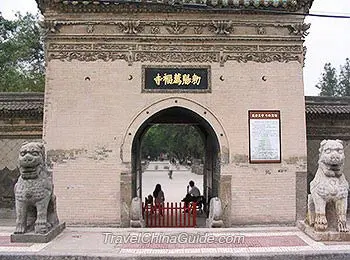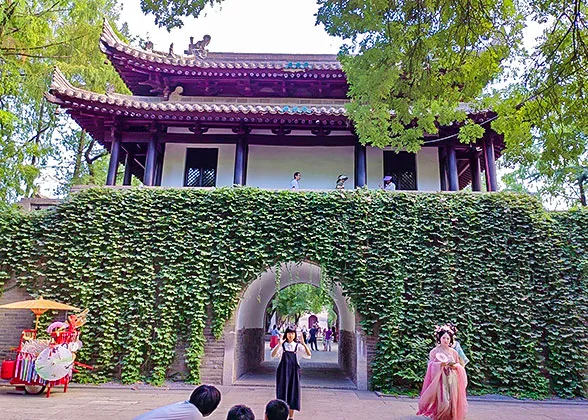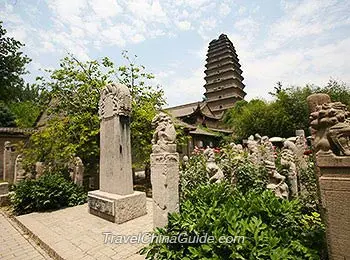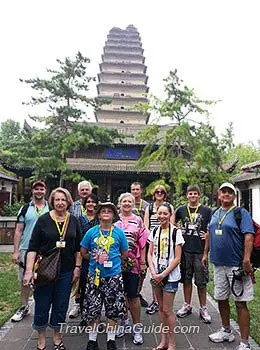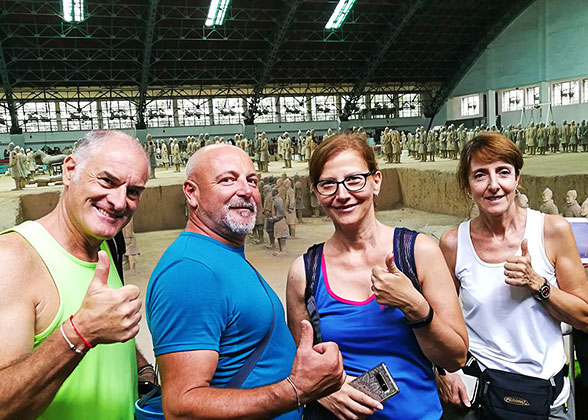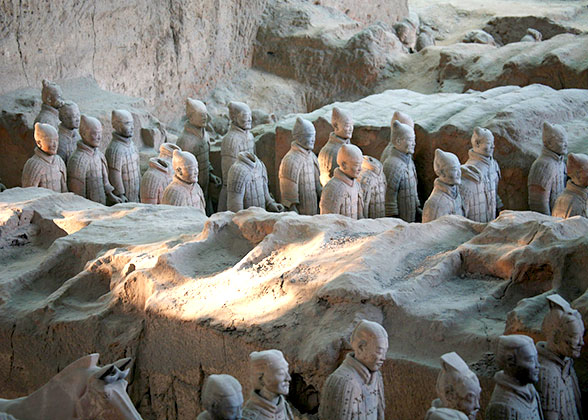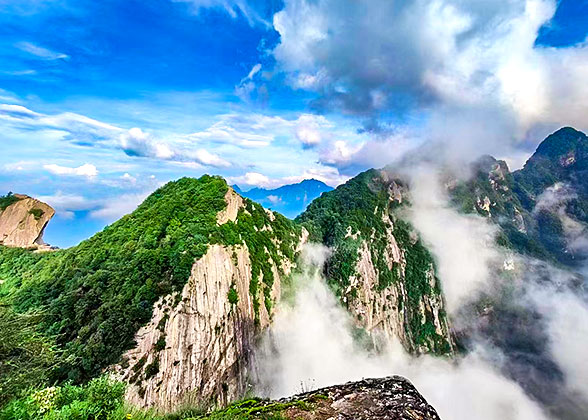Jianfu Temple
Jianfu Temple, adjacent to Xi’an Museum, is an ancient Buddhist shrine with tranquil scenery and historic buildings. The temple was originally built in 684 during the Tang Dynasty (618-907) for praying happiness for the emperor and also storing and translating Buddhist sutras brought back from India. The famous Small Wild Goose Pagoda, which was listed as a world cultural heritage site by UNESCO in 2014, is a representative building in the temple. Visiting the Jianfu Temple, you can not only admire the ancient pagoda and the other Buddhist buildings, but also learn the history of Xi’an in the nearby museum and admire natural views afterwards.
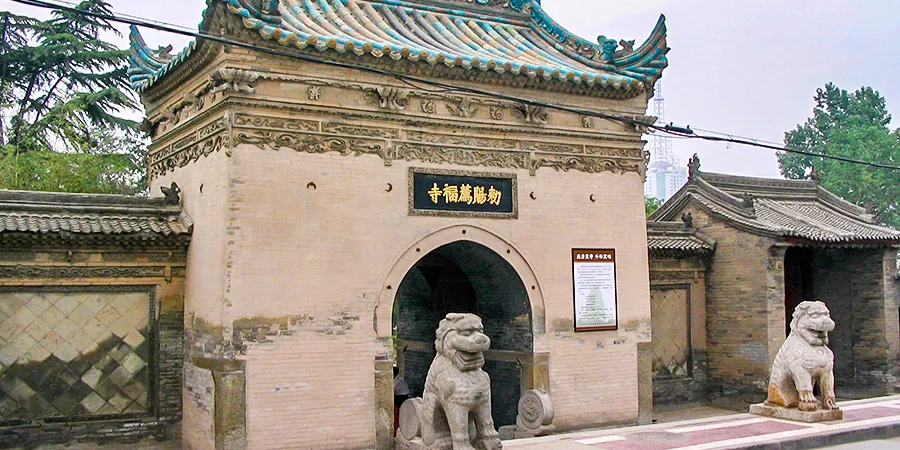 |
| South Gate of Jianfu Temple |
History of Over 1,340 Years
In order to pray for the Emperor Gaozong, the 3rd emperor of the Tang Dynasty, imperial members built the temple on the 100th day after his death in 684. It was first named “Xianfu Temple”, meaning “respectfully offering best wishes and blessings with material objects”. Later, in 690, the first year of the reign of the Empress Wu Zetian who is the only female emperor in China’s history, the temple got its present name, “Jianfu Temple”, meaning “respectfully offering and also praying for blessings both materially and mentally”.
In 706, the temple was transformed into a Translation Institute of Buddhist Scriptures. It attracted numerous eminent monks both from home and abroad to translate Buddhist sutras here.
Among all the monks, Yijing was the most distinguished. He was as famous as Xuanzang who presided over the translation of Buddhist scriptures in the Da Ci'en Temple, the location of Giant Wild Goose Pagoda. Yijing translated 108 volumes from 706 to 713, making the Jianfu Temple one of the three biggest translation institutes of Buddhist scriptures in China.
Symbolic Building: Small Wild Goose Pagoda
The currently 13-story-high Small Wild Goose Pagoda surviving from the Tang Dynasty is the highest and the landmark building of Jianfu Temple. The square brick pagoda measures 43.4 meters (142 feet) in height and its body features gently curving lines and multiple eaves. This building looks graceful because of its aesthetic design and the harmonious relation with surrounding buildings and plants.
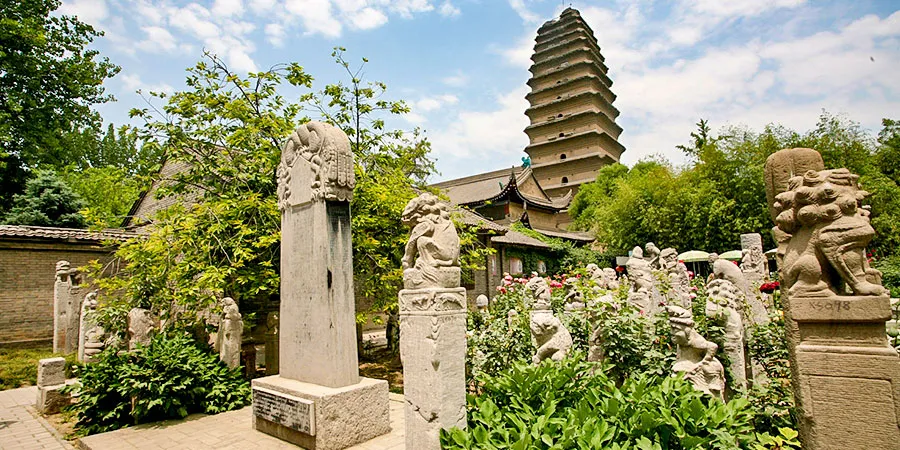 |
| Small Wild Goose Pagoda in Jianfu Temple |
What Others to See in Jainfu Temple
In addition to the Small Wild Goose Pagoda, the Jianfu Temple further comprises the Depository of Buddhist Sutras, the Mahavira Hall, the Cishi Pavilion, and the South Gate.
The Depository of Buddhist Sutras is a two-floor double-eave building, with five bays in length and three bays in width respectively divided by dark-red columns.
Built in the Qing Dynasty (1644-1911), the Mahavira Hall has a single eave. It measures 21.2 meters (23 yards) in length and 13.3 meters (14.5 yards) in width with five rooms. The supporting pillars are 3.8 meters (12.5 feet) high, with a diameter of 0.23 meter (9 inches).
|
|
The Cishi Pavilion was first constructed in the Ming Dynasty (1368-1644). It is a double-eave terrace with a wooden board inscribed with “Imperial Jianfu Temple”. There are brick stairs on the two sides, and a corridor in the middle.
Built in the late Qing Dynasty, the south gate has a length of 2.9 meters (3 yards) and a width of 2.55 meters (3 yards). It features a single eave embellished by blue glazed tiles and beautiful brick carvings under the eave. On the south of the gate hangs a plaque inscribed with “Imperial Jianfu Temple” while on the north is a plaque engraved with “the True Way”.
Morning Bell of Jianfu Temple
In the bell tower of the temple hangs a giant iron bell. Constructed in 1192 of the Jin Dynasty (1115-1234), the bell weighs about 8 tons, with a height of 3.5 meters (11.5 feet) and a diameter of 2.5 meters (2.7 yards). It originally belonged to the Shangge Temple which was destroyed in a terrible flood, and the bell sank into the bottom of the Weihe River.
One day in the Qing Dynasty, a woman heard the bang of metal when she was washing clothes by the Weihe River. Immediately she reported it to the local government. After searching, the bell which was lost for more than four hundred years was discovered. After being excavated, it was given to the Jianfu Temple.
In the following time, monks in the temple clanged the bell every morning to pray for happiness. Since then, the morning bell chime and also the Small Wild Goose Pagoda have been listed as one of eight wonderful views of Xi’an.
The original bell was cracked during the war and then was collected in the temple’s bell tower. In 1998, a copy of the bell was made. Tourists can toll it if interested.
|
|
Ancient Trees
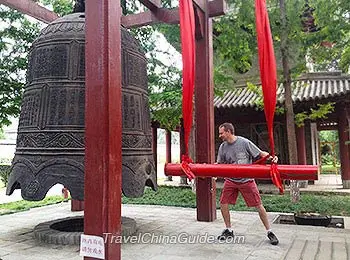 |
| Ancient Trees in Jianfu Temple |
The oldest one is called “the Dragon Scholar Tree” due to its curved and twisted branches. Being about 1,200 years old, the tree measures 2.7 meters (3 yards) in girth and 9.2 meters (30.2 feet) in height. Its lush green leaves provide shade for visitors on hot days, and its creamy-white flowers are in full bloom every June to July.
The catalpa tree is to the north of the Cishi Pavilion. With a girth of 3.2 meters (3.5 yards), a height of 15.3 meters (50.2 feet), and a history of about 800 years, it has been the oldest one of its kind in Xi’an. Every April, clusters of light pink flowers blossom vibrantly on its branches.
Jianfu Temple Travel Advice
1. All the buildings in the Jianfu Temple are closed and tourists can only admire them from the outside. Even though, the appearance of these buildings and also the plants in the temple are visit-worthy.
2. It’s highly recommended to wear Hanfu, traditional Chinese clothes during your tour and take photos with the ancient buildings, giving you the feeling of traveling back to old days.
3. A recommended viewing route is as follows:
The North Gate → Small Wild Goose Pagoda → visit the other buildings in the Jianfu Temple from north to south → enter the exhibition gallery of Xi’an Museum → go to the northwest region of the spot and enjoy lake and plant views → the north gate.
How to Get to Jianfu Temple
Nanshaomen is the closest metro station to the attraction’s North Gate, and you can take Metro Line 2 or Line 5 to the station, get out from Exit F, walk westward for about 6 minutes, and get to the North Gate.
(1) To the attraction’s North Gate: Take Bus No. 21, 40, 46, 203, 224, 258, 521, 410, 700, or Tourist Line 7, and get off at the Xiaoyanta / Small Wild Goose Pagoda Station.
(2) To the attraction’s West Gate: Take Bus No. 18, 203, 204, 218, 229, 258, 407, 410, or Tourist Line 7, get off at the Xiajiazhuang Station, and walk northward for about 4 minutes.
Xi'an Bus/ Metro Search| Ticket Price | The entire attraction is free of charge, but you need to book the admission ticket online or at the ticket office next to the attraction’s North Gate. You can make your booking at most 7 days in advance. |
| Opening Hours | 8:30-18:00, and admissions stop at 17:00. (1) From November to April, the attraction is closed every Tuesday and Chinese New Year Eve, except for China's public holidays. (2) From May to October, the attraction opens every day. (3) In summer holiday from July to August, the opening hours may be extended. |
Recommended Tours
- Last updated on Aug. 13, 2025 by Alex Jin -
